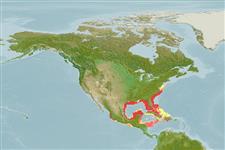Malacostraca |
Decapoda |
Sicyoniidae
Environment: milieu / climate zone / djupintervall / distribution range
Ekologi
; djupintervall 1 - 330 m (Ref. 8), usually 10 - 110 m (Ref. 112661). Tropical, preferred 25°C (Ref. 107945); 39°N - 14°N, 106°W - 70°W
Eastern Pacific and Western Atlantic: In the eastern Pacific from Colima to Chiapas, Mexico, and in the western Atlantic from Norfolk Virginia, along USA and Bahamas to the southern coast of Cuba, Gulf of Mexico from Florida Keys to Yucatan.
Length at first maturity / Size / Weight / Age
Könsmognad: Lm ? range ? - ? cm Max length : 15.3 cm TL hane/ej könsbestämd; (Ref. 8)
Minimum depth from Ref. 356. Prefers bottom white and shelly sand (Ref. 8). Generalized carnivore, feeds at night, mainly on mollusks and crustaceans (Ref. 111994).
Life cycle and mating behavior
Könsmognad | Reproduktion | Lek | Eggs | Fecundity | Larvae
Members of the order Decapoda are mostly gonochoric. Mating behavior: Precopulatory courtship ritual is common (through olfactory and tactile cues); usually indirect sperm transfer.
Holthuis, L.B. 1980 FAO Species Catalogue. Vol. 1. Shrimps and prawns of the world. An annotated catalogue of species of interest to fisheries. FAO Fish. Synop. 125(1):271 p. Rome: FAO. (Ref. 8)
IUCN Red List Status
(Ref. 130435: Version 2025-1)
CITES status (Ref. 108899)
Not Evaluated
Not Evaluated
Threat to humans
Human uses
Fiskeri: kommersiell
FAO - fiskeri: landings, species profile | FishSource | Sea Around Us
Verktyg
Ytterligare information
Population dynamicsTillväxtMax. ages / sizesLength-weight rel.Length-length rel.Length-frequenciesMass conversionAbundans PhysiologySyreförbrukning
Human RelatedStamps, coins, misc.
Internet-källor
Estimates based on models
Preferred temperature
(Ref.
115969): 10.2 - 27, mean 22.4 (based on 267 cells).
Prior r = 0.81, 95% CL = 0.54 - 1.22, Based on 1 data-limited stock assessment.
Fishing Vulnerability
Low vulnerability (10 of 100).
Climate Vulnerability
Moderate to high vulnerability (48 of 100).
Nutrients : Calcium = 109 [35, 184] mg/100g; Iron = 1.59 [1.21, 1.97] mg/100g; Protein = 20.2 [19.2, 21.3] %; Omega3 = 0.285 [0.185, 0.386] g/100g; Selenium = 48.3 [-31.7, 128.3] μg/100g; VitaminA = 0 μg/100g; Zinc = 1.79 [1.17, 2.40] mg/100g (wet weight); based on
nutrient studies.
